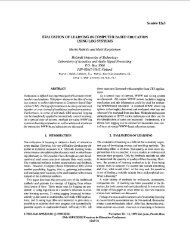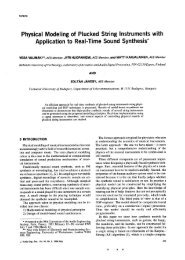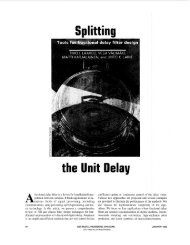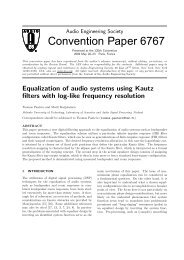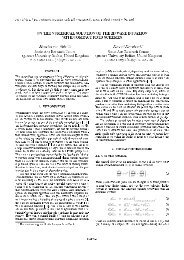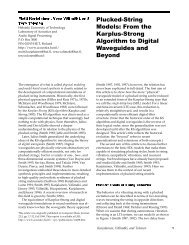A computationally efficient multipitch analysis model ... - IEEE Xplore
A computationally efficient multipitch analysis model ... - IEEE Xplore
A computationally efficient multipitch analysis model ... - IEEE Xplore
Create successful ePaper yourself
Turn your PDF publications into a flip-book with our unique Google optimized e-Paper software.
716 <strong>IEEE</strong> TRANSACTIONS ON SPEECH AND AUDIO PROCESSING, VOL. 8, NO. 6, NOVEMBER 2000[10] K. Kashino and H. Tanaka, “A sound source separation system withthe ability of automatic tone <strong>model</strong>ing,” Int. Computer Music Conf., pp.248–255, 1993.[11] A. Klapuri, “Number theoretical means of resolving a mixture of severalharmonic sounds,” in Proc. Signal Processing IX: Theories Applications,vol. 4, 1998, p. 2365.[12] K. D. Martin, “Automatic transcription of simple polyphonic music: Robustfront end processing,” Mass. Inst. Technol., Media Lab PerceptualComputing, Cambridge, Tech. Rep. 399, 1996.[13] , “A blackboard system for automatic transcription of simple polyphonicmusic,” Mass. Inst. Technol. Media Lab. Perceptual Computing,Cambridge, Tech. Rep. 385, 1996.[14] D. P. W. Ellis and B. L. Vercoe, “A wavelet-based sinusoid <strong>model</strong> ofsound for auditory signal separation,” in Int. Computer Music Conf.,1991, pp. 86–89.[15] USA Standard Acoustical Terminology, Amer. Nat. Stand. Inst., S1.1-1960, 1960.[16] R. Meddis and L. O’Mard, “A unitary <strong>model</strong> for pitch perception,” J.Acoust. Soc. Amer., vol. 102, pp. 1811–1820, Sept. 1997.[17] R. Meddis and M. Hewitt, “Virtual pitch and phase sensitivity of acomputer <strong>model</strong> of the auditory periphery—I: Pitch identification,” J.Acoust. Soc. Am., vol. 89, pp. 2866–2882, June 1991.[18] A. S. Bregman, Auditory Scene Analysis. Cambridge, MA: MIT Press,1990.[19] M. P. Cooke, “Modeling auditory processing and organization,” Ph.D.dissertation, Univ. Sheffield, Sheffield, U.K., 1991.[20] G. J. Brown, “Computational auditory scene <strong>analysis</strong>: A representationalapproach,” Ph.D. dissertation, Univ. Sheffield, Sheffield, U.K., 1992.[21] D. P. W. Ellis, “Prediction-driven computational auditory scene <strong>analysis</strong>,”Ph.D. dissertation, Mass. Inst. Technol., Cambridge, June 1996.[22] R. D. Patterson, “The sound of the sinusoid: Spectral <strong>model</strong>s,” J. Acoust.Soc. Amer., vol. 96, pp. 1409–1418, Sept. 1994.[23] B. C. J. Moore, R. W. Peters, and B. R. Glasberg, “Auditory filter shapesat low center frequencies,” J. Acoust. Soc. Amer., vol. 88, pp. 132–140,July 1990.[24] M. Slaney and R. F. Lyon, “A perceptual pitch detector,” Proc. <strong>IEEE</strong> Int.Conf. Acoustics, Speech, Signal Processing, vol. 1, pp. 357–360, 1990.[25] R. Carlyon and T. M. Shackleton, “Comparing the fundamental frequenciesof resolved and unresolved harmonics: Evidence for two pitchmechanisms?,” J. Acoust. Soc. Amer., vol. 95, pp. 3541–3554, June 1994.[26] R. P. Carlyon, “Comments on ‘a unitary <strong>model</strong> of pitch perception’,” J.Acoust. Soc. Amer., vol. 102, pp. 1118–1121, Aug. 1997.[27] B. R. Glasberg and B. C. J. Moore, “Derivation of auditory filter shapesfrom notched-noise data,” Hear. Res., vol. 47, pp. 103–138, 1990.[28] U. K. Laine, M. Karjalainen, and T. Altosaar, “Warped linear prediction(WLP) in speech and audio processing,” Proc. <strong>IEEE</strong> Int. Conf. Acoustics,Speech, and Signal Processing, pp. III.349–III.352, 1994.[29] E. D. Young and M. B. Sachs, “Representation of steady-state vowels inthe temporal aspects of the discharge patterns of populations of auditorynervefibers,” J. Acoust. Soc. Amer., vol. 66, pp. 1381–1403, Nov. 1979.[30] S. Seneff, “A joint synchrony/mean-rate <strong>model</strong> of auditory speech processing,”J. Phonetics, vol. 16, pp. 55–76, 1988.[31] H. Indefrey, W. Hess, and G. Seeser, “Design and evaluation of doubletransformpitch determination algorithms with nonlinear distortion inthe frequency domain—Preliminary results,” in Proc. <strong>IEEE</strong> Int. Conf.Acoustics, Speech, Signal Processing, 1985, pp. 11.11.1–11.11.4.[32] R. D. Patterson, M. H. Allerhand, and C. Giguère, “Time-domain <strong>model</strong>ingof peripheral auditory processing: A modular architecture and asoftware platform,” J. Acoust. Soc. Amer., vol. 98, pp. 1890–1894, Oct.1995.[33] T. Dau, B. Kollmeier, and A. Kohlrausch, “Modeling auditory processingof amplitude modulation—I. Detection and masking withnarrow-band carriers,” J. Acoust. Soc. Amer., vol. 102, pp. 2898–2905,Nov. 1997.[34] E. Zwicker and H. Fastl, Psychoacoustics: Facts and Models. Berlin,Germany: Springer-Verlag, 1990.[35] M. Karjalainen and T. Tolonen, “Multi-pitch and periodicity <strong>analysis</strong><strong>model</strong> for sound separation and auditory scene <strong>analysis</strong>,” in Proc. <strong>IEEE</strong>Int. Conf. Acoustics, Speech, and Signal Processing, vol. 2, 1999, pp.929–932.Tero Tolonen (S’98) was born in Oulu, Finland, in 1972. He majored inacoustics and audio signal processing and received the M.Sc.(Tech.) andLic.Sc.(Tech.) degrees in electrical engineering from the Helsinki Universityof Technology (HUT), Espoo, Finland, in January 1998 and December 1999,respectively. He is currently pursuing a postgraduate degree.He has been with the HUT Laboratory of Acoustics and Audio Signal Processingsince 1996. His research interests include <strong>model</strong>-based audio representationand coding, physical <strong>model</strong>ing of musical instruments, and digital audiosignal processing.Mr. Tolonen is a student member of the <strong>IEEE</strong> Signal Processing Society andthe Audio Engineering Society.Matti Karjalainen (M’84) was born in Hankasalmi, Finland, in 1946. He receivedthe M.Sc. and Dr.Tech. degrees in electrical engineering from the TampereUniversity of Technology, Tampere, Finland, in 1970 and 1978, respectively.His doctoral dissertation dealt with speech synthesis by rule in Finnish.From 1980 to 1986, he was Associate Professor and, since 1986, FullProfessor of acoustics with the Faculty of Electrical Engineering, HelsinkiUniversity of Technology, Espoo, Finland. His research activities cover speechsynthesis, <strong>analysis</strong>, and recognition, auditory <strong>model</strong>ing and spatial hearing,DSP hardware, software, and programming environments, as well as variousbranches of acoustics, including musical acoustics and <strong>model</strong>ing of musicalinstruments.Dr. Karjalainen is a fellow of the AES and a member of ASA, EAA, ICMA,ESCA, and several Finnish scientific and engineering societies. He was the GeneralChair of the 1999 <strong>IEEE</strong> Workshop on Applications of Audio and Acoustics,New Paltz, NY.







